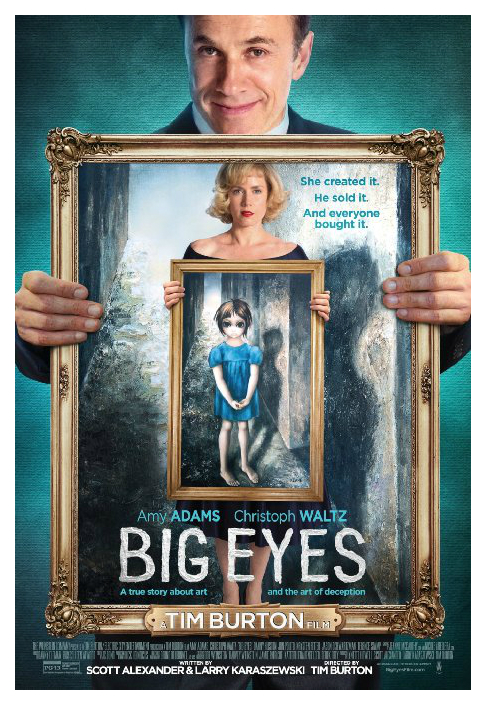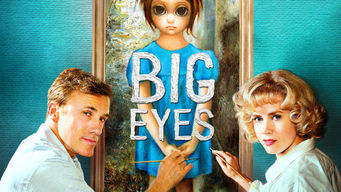It is often said that beauty lies in the eye of the
beholder. It is also a commonly held belief that the best art is that which
contains or reveals some universal truth. In the 2014 historical drama Big Eyes, the importance of truth and
beauty in art propel a media sensation and a landmark legal case. Beautiful or not, the true story behind
Margaret Keane’s iconic ‘big eyes’ paintings is every bit as haunting and
polarizing as the paintings themselves and startlingly relevant in today’s era
of instant celebrity.
 |
| The juciest art scandal this side of the Gardner Museum Heist |
The story begins in 1958 as recent divorcee Margaret Ulbricht
(Amy Adams) sets out in search of a fresh start in San Francisco with her young
daughter, Jane (Delaney Raye and Emily Bruhn) in tow. While trying to sell her
paintings of large eyed waifs at a local art fair she meets and is instantly
captivated by charming fellow artist Walter Keane (Christoph Waltz). The pair
embark upon a whirlwind romance, and are soon married. Much to her dismay,
however, the marriage does not provide the financial security she had hoped for
and the couple turn to selling their art as a second income. Eventually, Walter
convinces a local club owner (Jon Polito) to rent out wall space in his club to
display their art. When Walter gets into a drunken brawl with the club owner
that ends up making local news, the paintings become a local curiosity and
Margaret’s work begins selling...with Walter listed as the artist. Manipulated
into presenting the paintings as his, she takes a secondary role in her
relationship and career, which quickly weighs upon her conscience. When the
media frenzy surrounding the paintings incites a critical backlash from the art
world the pair’s relationship finally reaches its breaking point. Margaret
ultimately flees her second marriage and reinvents herself in Hawaii as a
devout Jehovah’s Witness. Her renewed faith in God and herself provide her with
the strength to reveal the tangled truth about her life and work, and finally
dispel the big lies surrounding the iconic big eyes.
Big
Eyes
sets itself apart from other historical dramas by looking beyond the facts of
the Keanes’ deception to the motivations behind it. Through its exploration of
Margaret’s reluctant acceptance of Walter’s scheme to her eventual revolt
against it, the film depicts an apt portrayal of changing gender roles in 1960’s
America. When viewers are first introduced to her, Margaret is still reeling
from her recent divorce and finds herself adrift in the cutting edge culture of
60’s California. This initial impression provides crucial insight into her
mindset, and explains why she was so drawn to Walter and the supposed security
he represented. Similarly, her failed attempts to launch her career as an
artist leave little wonder as to why she accepted his argument that her work
would only sell if sold under a male artist’s name. As a result, the film makes
sense of Margaret’s otherwise baffling choices by placing her decisions within the
historical context of the era she is inhabiting. Through its focus upon the
external factors that drive Margaret, the film presents her story in such a way
that her efforts to find herself and reclaim her work directly parallel the
ways in which millions of American women in her generation claimed their place
beyond the confines of traditional roles.
 |
| Talk about Bette Davis eyes! |
Beyond any political ideas it may invoke, Big Eyes is first and foremost a
character study and director Tim Burton sheds a by turns sympathetic and
critical eye upon his complex characters. Rather than relying upon the lavish
special effects or garish costuming that his films have become known for,
Burton returns to his roots in this deceptively simple tale of a search for
artistic recognition gone outrageously awry. Much like his early hit, Ed Wood, the film poignantly depicts the
by turns perilous and fulfilling pursuit of a life in the arts. The film differs
from its predecessor, however, in that it unflinchingly portrays the ways in which
the need for critical and monetary success can embitter even the most sincere
artist. Despite the darkness of the film’s subject matter, however, Burton’s
light approach and obvious affection for his characters allows the story to simultaneously
serve as both a cautionary tale of what we leave behind on our journey to the
top, and a heartfelt tribute to the redeeming power of art. Equal parts
feminist allegory and offbeat character study there’s nothing small about the
ideas and themes explored in Big Eyes.
The talented ensemble cast brings the stranger than
fiction tale of the Keane paintings to vibrant life. The supporting cast lend
apt performances with Danny Huston and Krysten Ritter earning particular notice
in their roles as a cynical reporter and Margaret’s worldly best friend.
Delaney Raye and Emily Bruhn are equally believable in their portrayals of
Margaret’s daughter, Jane and excellently capture the ways in which the Keanes’
fraught relationship and the lies surrounding it impact her as she grows older.
Christoph Waltz and Amy Adams each hold their own as Margaret and Walter and
portray the couple’s relationship with a depth and nuance that sheds light on
how and why the pair propagated one of the greatest deceptions in art history.
Waltz’s performance showcases Walter’s con-man charm while slowly revealing the
sinister motivations lurking beneath his amiable façade. Adams paints a
sympathetic portrait of Margaret as she evolves from insecure to resilient
without downplaying her complicity in Walter’s scheme.
The ‘big eyes’ paintings are considered products of
the commercialism of 1960’s pop culture, but the story behind Big Eyes is truly one for the ages.
Through its combination of an intelligent script, a uniformly superb cast, and
timeless themes, the film relates a historical tale that continues to resonate
today. Part historical drama and part inspirational tale, Big Eyes artfully portrays truths about the search for self and
recognition that extend far beyond the confines of its 60’s pop art setting. For
a bit of art history that is truly too strange to be fiction take a glimpse at Big Eyes.
 |
| Warhol had nothing on this marketing team |

No comments:
Post a Comment